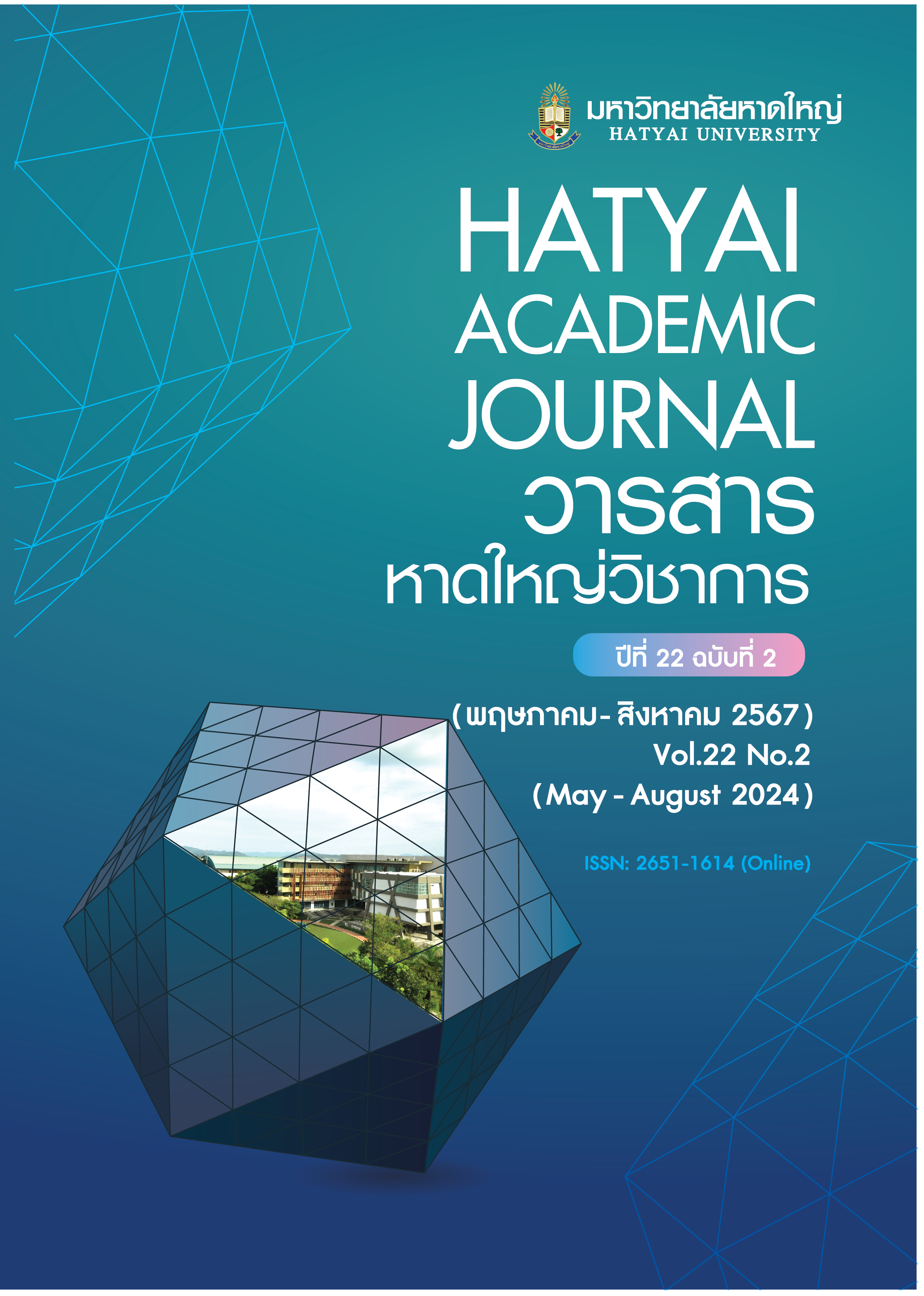Validation and Psychometric Properties of the Thai Version of Phubbing Scale in Adolescents
Main Article Content
Abstract
This study aimed to validate and assess the psychometric properties of the Thai version Phubbing Scale in adolescents. With the proliferation of smartphone use, the phenomenon of “phubbing”, or snubbing someone in favor of one’s phone, has become increasingly prevalent. To address this, a reliable and culturally appropriate measurement tool was essential. The Thai Phubbing Scale, consisting of eight items, was translated following established guidelines, and tested among 280 Thai participants.
The results indicated that the scale demonstrated good internal consistency, with Cronbach’s alpha coefficients of 0.80 for the total scale, 0.76 for Communication Disturbance, and 0.77 for Phone Obsession. Exploratory factor analysis confirmed a consistent two-factor structure, accounting for 59.9 percent of the total variance. Confirmatory factor analysis (CFA: CMIN/DF = 3.097, GFI = .950, RMSEA = .087, CFI = .940, NFI = .915, PNFI = .621, and TLI = .911) supported the scale’s construct validity. These findings suggested that the Thai version of the Phubbing Scale is a reliable instrument for assessing phubbing behaviors among Thai adolescents.
Article Details

This work is licensed under a Creative Commons Attribution-NonCommercial-NoDerivatives 4.0 International License.
All published articles are evaluated by three qualified peer reviewers from various institutions through a double-blind process, where reviewers do not know the authors’ identities and authors do not know the reviewers’ identities. The content and articles in the Hatyai Academic Journal reflect the authors’ views only and are neither the opinions of the editorial board nor the responsibility of Hatyai University. The Editorial Board of the Hatyai Academic Journal allows articles to be reproduced for academic purposes, on the condition that the original source is clearly cited.
References
Bartlett, M.S. (1950). Tests of significance in factor analysis. British Journal of Psychology, 3(2), 77–85. https://doi.org/10.1111/j.2044-8317.1950.tb00285.x
Beaton, D. E., Bombardier, C., Guillemin, F., & Ferraz, M. B. (2000). Guidelines for the process of cross-cultural adaptation of self-report measures. Spine, 25(24), 3186–3191.
Błachnio, A., Przepiórka, A., Gorbaniuk, O., Bendayan, R., McNeill, M., Angeluci, A., … Yu, S. (2021). Measurement invariance of the Phubbing Scale across 20 countries. International Journal of Psychology, 56(6), 885–894. https://doi.org/10.1002/ijop.12790
Blanca, M. J., & Bendayan, R. (2018). Spanish version of the phubbing scale: Internet addiction, Facebook intrusion, and fear of missing out as correlates. Psicothema, 30(4), 449 – 454. doi: 10.7334/psicothema2018.153
Buckle, C. (2016). Mobiles seen as most important device. Retrieved from https://www.globalwebindex.net/blog/mobiles-seen-as-most-important-device
Cerny, B. A., & Kaiser, H. F. (1977). A study of a measure of sampling adequacy for factor-analytic correlation matrices. Multivariate Behavioral Research, 12, 43–47. http://dx.doi.org/10.1207/s15327906mbr1201_3
Child, D. (2006). The Essentials of factor analysis (3rd ed.). New York: Continuum.
Chotpitayasunondh, V., & Douglas, K. M. (2018). The effects of "phubbing" on social interaction. Journal of Applied Social Psychology, 48(6), 304-316. https://doi.org/10.1111/jasp.12506
Field, A. (2013). Discovering statistics using SPSS (4th ed.). London: SAGE.
Garrido, E. C., Issa, T., Esteban, P. G., & Delgado, S. C. (2021). A descriptive literature review of phubbing behaviors. Heliyon, 7, e070037. https://doi.org/10.1016/j.heliyon. 2021. e07037.
García-Castro, F. J., Abreu, A. M., Rando, B., & Blanca, M. J. (2022). The Phubbing Scale (PS-8) in the Portuguese population: Psychometric properties. Psicologia: Reflexão e Crítica, 35(7), 1-9. https://doi.org/10.1186/s41155-022-00209-z
Guadagnoli, E., & Velicer, W. F. (1988). Relation of sample size to the stability of component patterns. Psychological Bulletin, 103(2), 265-275.
Guillemin, F., Bombardier, C., & Beaton, D. (1993). Cross cultural adaptation of health-related quality of life measures: Literature review and proposed guidelines. J Clin Epidemiol, 46, 1417-1432. doi: 10.1016/0895-4356(93)90142-N
Haigh, A. (2012). Stop phubbing. Retrieved from http://stopphubbing.com
Hobart, J., & Cano, S. (2009). Improving the evaluation of therapeutic interventions in multiple sclerosis: The role of new psychometric methods. Health Technol. Assessment, 13(12), ii, ix-x, 1-177. doi: 10.3310/hta13120
Kaiser, H. F., & Rice, J. (1974). Little jiffy, mark iv. Educational and Psychological Measurement, 34(1), 111-117. https://doi.org/10.1177/001316447403400115
Karadağ, E., Tosuntaş, S. B., Erzen, E., Duru, P., Bostan, N., Şahin, B. M., & Babadağ, B. (2015). Determinants of phubbing, which is the sum of many virtual addictions: A structural equation model. Journal of Behavioral Addictions, 4(2), 60–74. https://doi.org/10.1556/2006.4.2015.005
Kline, R. B. (2015). Principles and practice of structural equation modeling. New York: Guilford Press.
Leach, C. W., van Zomeren, M., Zebel, S., Vliek, M. L. W., Pennekamp, S. F., Doosje, B., …
Spears, R. (2008). Group-level self-definition and self-investment: A hierarchical (multicomponent) model of in-group identification. Journal of Personality and Social Psychology, 95(1), 144-165.
Lei, P. W., & Wu, Q. (2007). Introduction to structural equation modeling: Issues and practical considerations. Educational Measurement: Issues and Practice, 26(3), 33–43. https://doi.org/10.1111/j.1745-3992.2007.00099.x
Nunnally, J. C., & Bernstein, I. H. (1994). Psychometric theory (3rd ed.). New York: McGraw-Hill.
Ranie, L., & Zickuhr, K. (2015). Americans’ views on mobile etiquette. Retrieved from http://www.pewinternet.org/2015/08/26/americans-views-on-mobile-etiquette.
Roberts, J. A., & David, M. E. (2017). Put down your phone and listen to me: How boss phubbing undermines the psychological conditions necessary for employee engagement. Computer in Human Behavior, 75, 206–217.
Schneider, F. M., & Hitzfeld, S. (2019). I ought to put down that phone but I phub nevertheless: Examining the predictors of phubbing behavior. Social Science Computer Review, 39(6), 1075-1088. https://doi.org/10.1177/0894439319882
Turkle, S. (2012). Alone together: Why we expect more from technology and less from each other. New York: Basic Books.
Worthington, R. L., & Whittaker, T. A. (2006). Scale development research: A content analysis and recommendations for best practices. The Counseling Psychologist, 34, 806-838. https://doi.org/10.1177/0011000006288127

